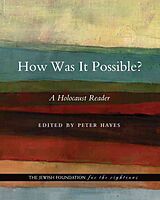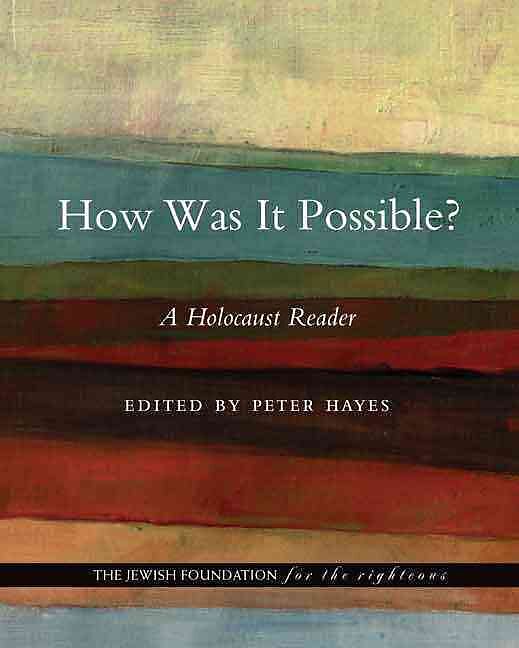How Was It Possible?
Einband:
Kartonierter Einband
EAN:
9780803274693
Untertitel:
A Holocaust Reader
Genre:
Geschichte
Autor:
Peter Hayes
Herausgeber:
Nebraska
Anzahl Seiten:
920
Erscheinungsdatum:
01.04.2015
ISBN:
978-0-8032-7469-3
Informationen zum Autor Peter Hayes is a professor of history and Theodore Zev Weiss Holocaust Educational Foundation Professor of Holocaust Studies at Northwestern University. He is the author of From Cooperation to Complicity: Degussa in the Third Reich and Industry and Ideology: IG Farben in the Nazi Era. Harvey Schulweis is chairman of the Jewish Foundation for the Righteous. Klappentext As the Holocaust passes out of living memory, future generations will no longer come face-to-face with Holocaust survivors. But the lessons of that terrible period in history are too important to let slip past. How Was It Possible?, edited and introduced by Peter Hayes, provides teachers and students with a comprehensive resource about the Nazi persecution of Jews. Deliberately resisting the reflexive urge to dismiss the topic as too horrible to be understood intellectually or emotionally, the anthology sets out to provide answers to questions that may otherwise defy comprehension. This anthology is organized around key issues of the Holocaust, from the historical context for antisemitism to the impediments to escaping Nazi Germany, and from the logistics of the death camps and the carrying out of genocide to the subsequent struggles of the displaced survivors in the aftermath. Prepared in cooperation with the Jewish Foundation for the Righteous, this anthology includes contributions from such luminaries as Jean Ancel, Saul Friedlander, Tony Judt, Alan Kraut, Primo Levi, Robert Proctor, Richard Rhodes, Timothy Snyder, and Susan Zuccotti. Taken together, the selections make the ineffable fathomable and demystify the barbarism underlying the tragedy, inviting readers to learn precisely how the Holocaust was, in fact, possible. Zusammenfassung As the Holocaust passes out of living memory, future generations will no longer come face-to-face with Holocaust survivors. But the lessons of that terrible period in history are too important to let slip past. How Was It Possible?, edited and introduced by Peter Hayes, provides teachers and students with a comprehensive resource about the Nazi persecution of Jews. Inhaltsverzeichnis List of IllustrationsForewordHarvey SchulweisIntroductionPeter HayesEditorial NoteChapter 1. The ContextIntroductionPeter Hayes[1.1] AntisemitismRobert S. Wistrich, from Antisemitism: The Longest Hatred[1.2] RacismMichael Burleigh and Wolfgang Wippermann, from The Racial State[1.3] Contradictions in Central EuropeAmos Elon, from The Pity of It All[1.4] Germany's Turmoil, 19181933Klaus P. Fischer, from Nazi Germany: A New History[1.5] The Interwar Jewish HeartlandEzra Mendelsohn, from The Jews of East Central Europe Between the World WarsChapter 2. Nazism in PowerIntroductionPeter Hayes[2.1] Elite CooperationEckart Conze et al., from Das Amt und die Vergangenheit [The Office and the Past][2.2] Street-Level CoercionSebastian Haffner, from Defying Hitler[2.3] The Claims of CommunityThomas Kühne, from Belonging and Genocide[2.4] AryanizationAvraham Barkai, from From Boycott to Annihilation[2.5] Talk of AnnihilationErnst von Weizsäcker's Remarks to a Swiss Diplomat, November 15, 1938, from Documents Diplomatiques SuissesJews, What Now? from Das Schwarze Korps, November 24, 1938Hitler's Reichstag Speech, January 30, 1939, from Nazism 19391945Chapter 3. Impediments to EscapeIntroductionPeter Hayes[3.1] The United States and Refugees, 19331940Richard Breitman and Alan M. Kraut, from American Refugee Policy and European Jewry, 19331945[3.2] France: From Hospitality to HostilityEugen Weber, from The Hollow Years[3.3] The Unreceptive British EmpireLouise London, from Whitehall and the Jews, 19331948[3.4] SwitzerlandIndependent Commission of Experts SwitzerlandSecond World War, from Switzerland, National Socialism, and the Second World War[3.5] PalestineRebecca Boehling and Uta Larkey, from Life and Loss in the Shadow of the Holocaust[3.6] Going and StayingMarion Kaplan, from Between ...
Klappentext
As the Holocaust passes out of living memory, future generations will no longer come face-to-face with Holocaust survivors. But the lessons of that terrible period in history are too important to let slip past. How Was It Possible?, edited and introduced by Peter Hayes, provides teachers and students with a comprehensive resource about the Nazi persecution of Jews. Deliberately resisting the reflexive urge to dismiss the topic as too horrible to be understood intellectually or emotionally, the anthology sets out to provide answers to questions that may otherwise defy comprehension.
This anthology is organized around key issues of the Holocaust, from the historical context for antisemitism to the impediments to escaping Nazi Germany, and from the logistics of the death camps and the carrying out of genocide to the subsequent struggles of the displaced survivors in the aftermath.
Prepared in cooperation with the Jewish Foundation for the Righteous, this anthology includes contributions from such luminaries as Jean Ancel, Saul Friedlander, Tony Judt, Alan Kraut, Primo Levi, Robert Proctor, Richard Rhodes, Timothy Snyder, and Susan Zuccotti. Taken together, the selections make the ineffable fathomable and demystify the barbarism underlying the tragedy, inviting readers to learn precisely how the Holocaust was, in fact, possible.
Inhalt
List of IllustrationsForewordHarvey SchulweisIntroductionPeter HayesEditorial Note
Chapter 1. The ContextIntroductionPeter Hayes[1.1] AntisemitismRobert S. Wistrich, from Antisemitism: The Longest Hatred[1.2] RacismMichael Burleigh and Wolfgang Wippermann, from The Racial State[1.3] Contradictions in Central EuropeAmos Elon, from The Pity of It All[1.4] Germany’s Turmoil, 1918–1933Klaus P. Fischer, from Nazi Germany: A New History[1.5] The Interwar Jewish HeartlandEzra Mendelsohn, from The Jews of East Central Europe Between the World Wars
Chapter 2. Nazism in PowerIntroductionPeter Hayes[2.1] Elite CooperationEckart Conze et al., from Das Amt und die Vergangenheit [The Office and the Past][2.2] Street-Level CoercionSebastian Haffner, from Defying Hitler[2.3] The Claims of CommunityThomas Kühne, from Belonging and Genocide[2.4] AryanizationAvraham Barkai, from From Boycott to Annihilation[2.5] Talk of “Annihilation”Ernst von Weizsäcker’s Remarks to a Swiss Diplomat, November 15, 1938, from Documents Diplomatiques Suisses“Jews, What Now?” from Das Schwarze Korps, November 24, 1938Hitler’s Reichstag Speech, January 30, 1939, from Nazism 1939–1945
Chapter 3. Impediments to EscapeIntroductionPeter Hayes[3.1] The United States and Refugees, 1933–1940Richard Breitman and Alan M. Kraut, from American Refugee Policy and European Jewry, 1933–1945[3.2] France: From Hospitality to HostilityEugen Weber, from The Hollow Years[3.3] The Unreceptive British EmpireLouise London, from Whitehall and the Jews, 1933–1948[3.4] SwitzerlandIndependent Commission of Experts Switzerland—Second World War, from Switzerland, National Socialism, and the Second World War[3.5] PalestineRebecca Boehling and Uta Larkey, from Life and Loss in the Shadow of the Holocaust[3.6] Going and StayingMarion Kaplan, from Between Dignity and Despair
Chapter 4. The New Order in EuropeIntroductionPeter Hayes[4.1] Culling the German VolkRobert N. Proctor, from Racial Hygiene[4.2] Rearranging PopulationsGötz Aly and Suzanne Heim, from Architects of Annihilation[4.3] Racial War in the EastTimothy Snyder, from Bloodlands[4.4] Plunder, Individual and GovernmentalGötz Aly, …

Leider konnten wir für diesen Artikel keine Preise ermitteln ...
billigbuch.ch sucht jetzt für Sie die besten Angebote ...
Die aktuellen Verkaufspreise von 6 Onlineshops werden in Realtime abgefragt.
Sie können das gewünschte Produkt anschliessend direkt beim Anbieter Ihrer Wahl bestellen.
Loading...
Die aktuellen Verkaufspreise von 6 Onlineshops werden in Realtime abgefragt.
Sie können das gewünschte Produkt anschliessend direkt beim Anbieter Ihrer Wahl bestellen.
| # | Onlineshop | Preis CHF | Versand CHF | Total CHF | ||
|---|---|---|---|---|---|---|
| 1 | Seller | 0.00 | 0.00 | 0.00 |
